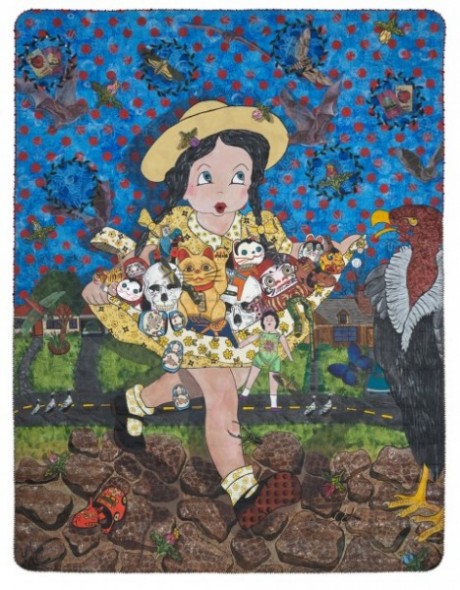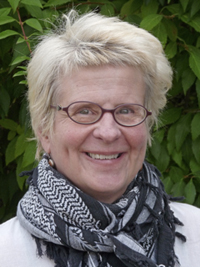
Artist’s Statement
I am obsessed with imagery, and will freely admit that I am a grangerizer, gathering goods from a variety of influences and sources. Hours are spent in thrift stores, as the hunt is part of the process. I am drawn to the dark underbelly of life which is often portrayed with a pretty candy-colored coating.
Inspiration comes to me at the oddest times. Often it is just at glance at some object or as subtle as a slap in the face.
I suppose I am also a storyteller. The stories I tell through my work reflect the way I view the world, often a brash voice in a room of hushed tones. My sometimes controversial work arises more from conviction than contrariness. How one might interpret my work is, of course, unquestionably personal.
Some things never change. I continue to work today much in the same way I did when I was young: hunting, scavenging, cutting, ripping, pasting, enlarging, reducing and waiting for the divine moment when everything falls into place.

Biography
Wendy Huhn was born in 1953 at Good Samaritan Hospital, Phoenix, Arizona. She received her BFA from the University of Oregon in Eugene in 1980.
Huhn was the recipient of the Quilt Japan Award from the Nihon Vogue Corporation, Tokyo, Japan. She was awarded a Oregon Arts Commission grant which allowed her time to explore the ancient art of grave rubbing.
Huhn currently lives and works in the Lost Creek Valley, nestled in the foothills of the Cascades. Huhn’s work is included in numerous public and private collections including: The Museum of Art and Design, New York, New York; Nihon Vogue, Tokyo, Japan; The Ardis and Robert James Collection of the International Quilt Study Center at the University of Nebraska Sonny Kamm Collection, Los Angeles, California; Gail Brown Collection, Philadelphia, Pennsylvania; and the George Stroemple Collection in Portland, Oregon.
Wendy works primarily in textiles, collage and mixed media, superimposing imagery on painted and sanded canvas or small hand embroidered collages. She occasionally goes off on artistic tangents, like constructing a 14-foot, lifelike giraffe sculpture, or painting traffic boxes in downtown Eugene.
Huhn continues to be fascinated and experiment with various methods of transferring images, designs and patterns to cloth. She is considered a forerunner in the various transfer techniques that she has worked extensively with in the last 29 years.

Hemochromatosis or Iron Overload Disorder
The first time I ever heard this term was in 1998 when I was diagnosed. In a nutshell: IOD is the hereditary iron overloading of vital organs and joints. Left untreated it can literally rust the body to death. How do you know if you have it? Typically someone in your family dies and IOD is discovered upon autopsy. This person is known as the “sacrificial sibling.”
A simple blood test can determine if you are at risk. Symptoms may vary from anemia to chronic fatigue, etc. This is most commonly undiagnosed treatable disorder, meaning you don’t have to die. Treatment? In past centuries it was simple: leeches. Now phlebotomies are used to rapidly reduce iron. For me it was one unit of blood once a week. (I still think I’d prefer leeches.) My family has been tested. My parents both have the recessive gene while my eldest sister also has IOD. We are lucky that I was diagnosed. In making this quilt, I hope to educate the viewer through humor to be tested so in the 21st century hemochromatosis will no longer bear the name of Silent Killer.
Pictured at left is Silent Killer, which will be shown in the exhibit Quilt (R)Evolution: Art Quilt Retrospective 1979-2014 , September 19 through Nov.23 2014 at the The Dairy Barn Arts Center, Athens, OH
